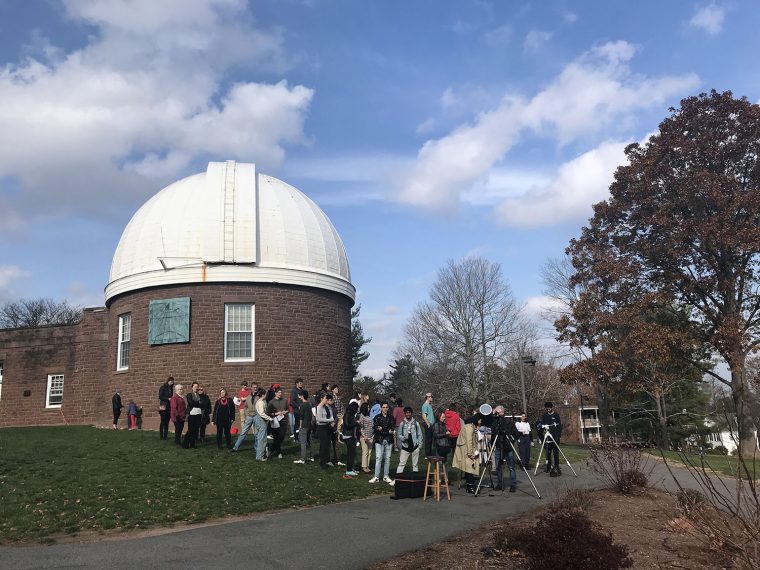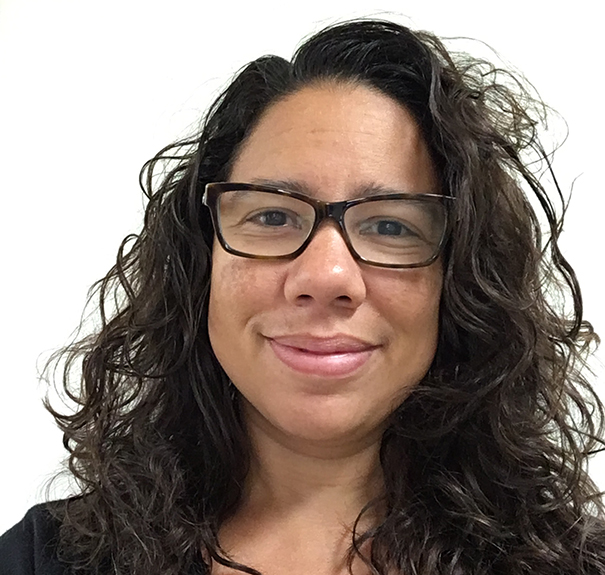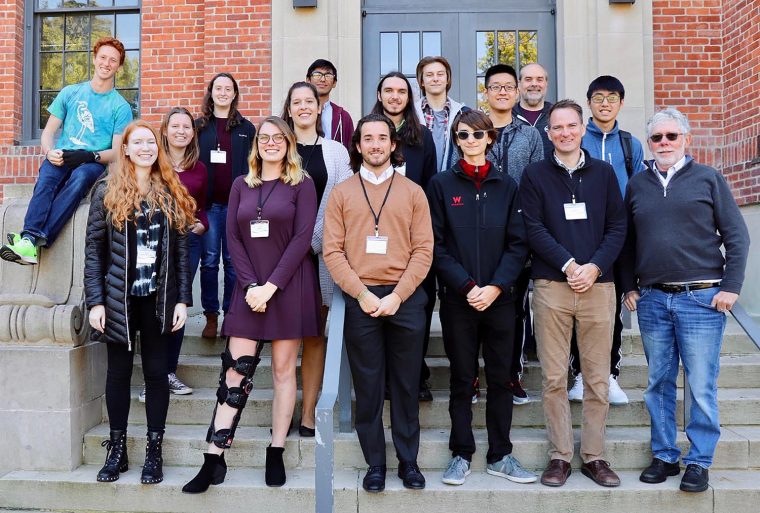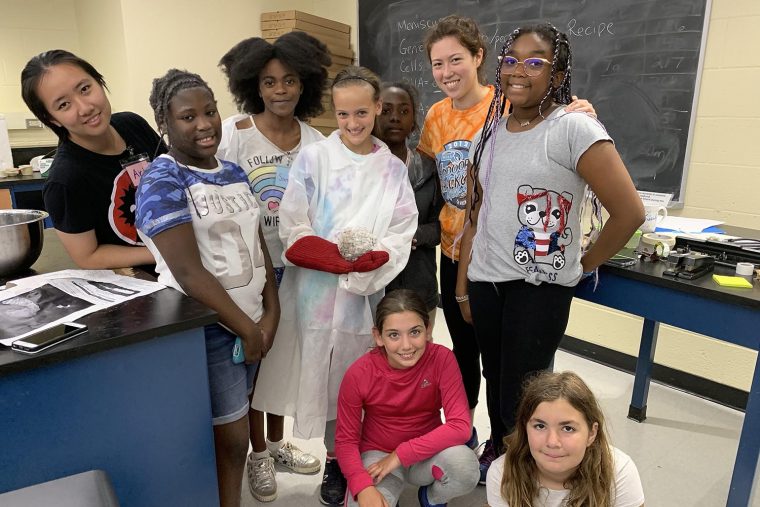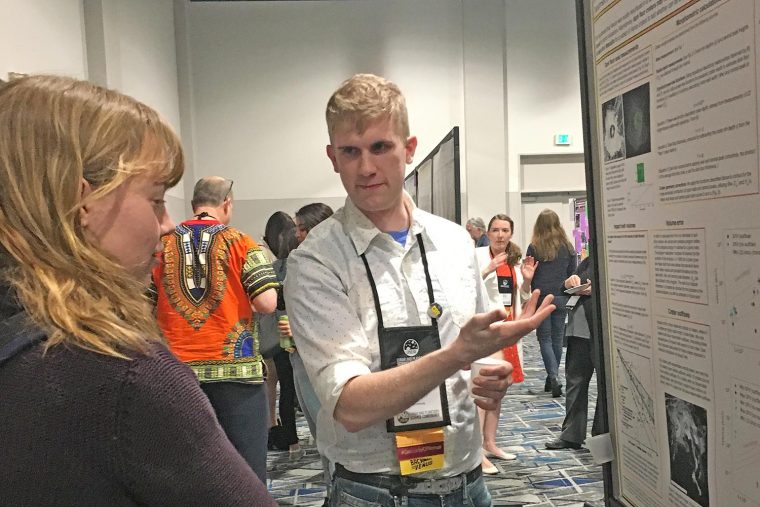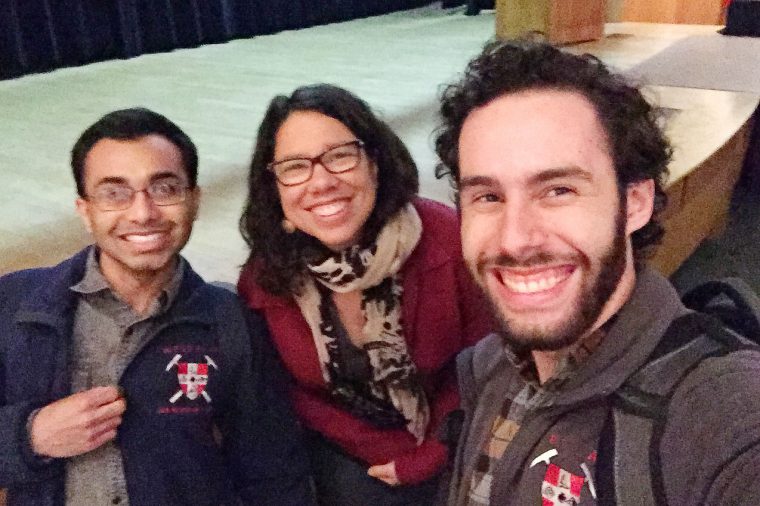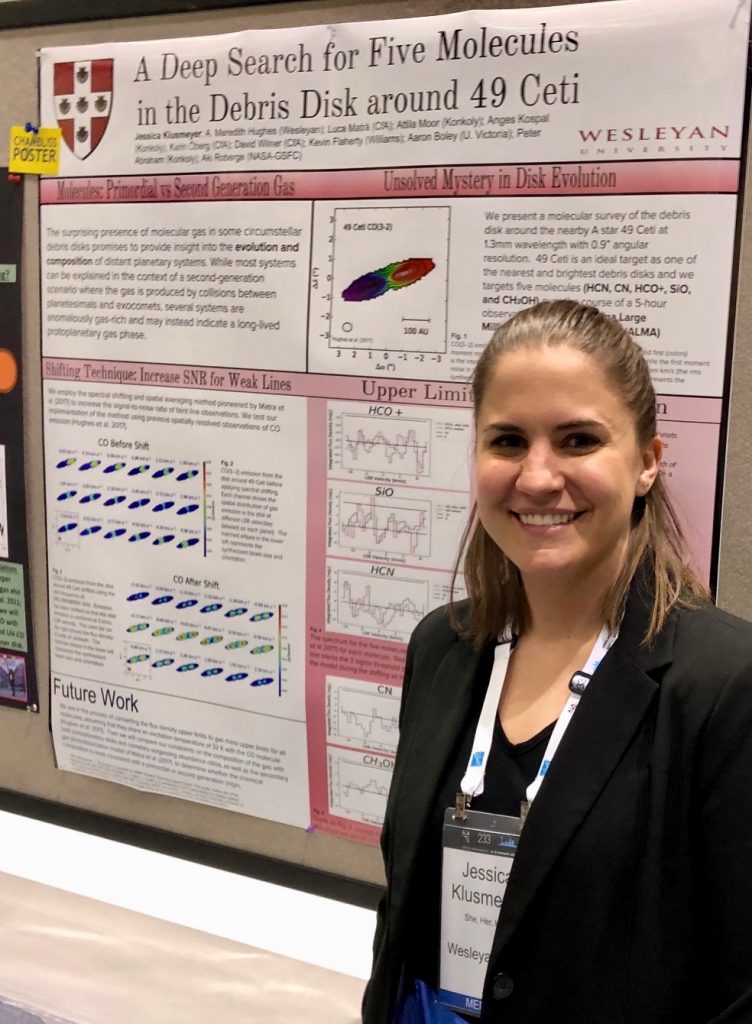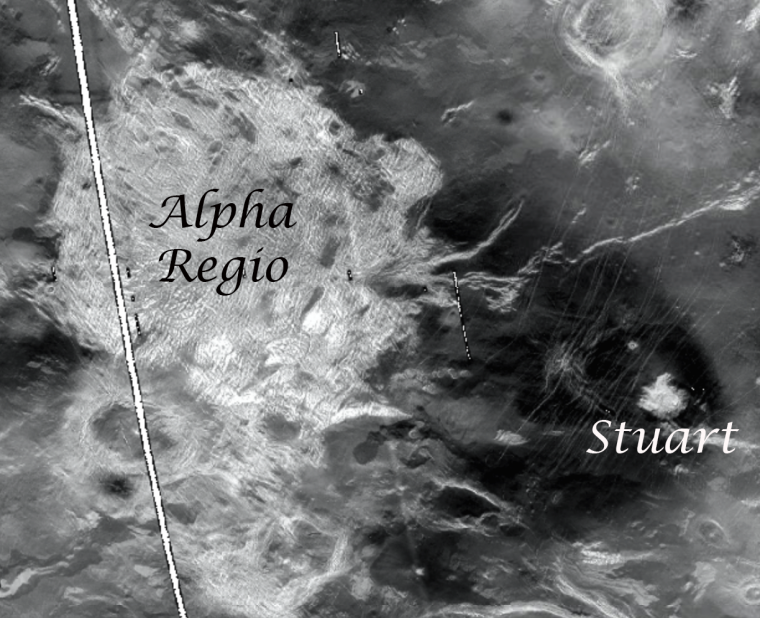Martha "Marty" Gilmore, George I. Seney Professor of Geology, professor of earth and environmental sciences, is the author of a research article titled "Present-day volcanism on Venus as evidenced from weathering rates of olivine," published in Science Advances Vol. 6 on Jan. 3, 2020. According to the paper's abstract: At least some of Venus’ lava flows are thought to be <2.5 million years old based on visible to near-infrared (VNIR) emissivity measured by the Venus Express spacecraft. However, the exact ages of these flows are poorly constrained because the rate at which olivine alters at Venus surface conditions, and how that…
For only the seventh time since Wesleyan’s founding, the planet Mercury passed directly in front of the sun, from the perspective of Earth—and Wesleyan served as a gathering place from which to learn about and observe the event. Faculty and students from Wesleyan’s astronomy department, as well as others from the University and the greater Middletown community, gathered outside the Van Vleck Observatory on Nov. 11 to witness the transit through three telescopes. The mild weather and partly cloudy conditions—particularly at the beginning and end of the transit (which lasted from 7:35 a.m. to 1:04 p.m.)—made for good viewings through…
Martha Gilmore, the George I. Seney Professor of Geology, professor of earth and environmental sciences, believes we have a lot to learn from studying Venus—yet the United States has not sent a mission to the Earth-sized planet since the early 1990s. That’s why Gilmore has proposed a major flagship mission concept study to assess whether Venus was ever a habitable planet by looking at its rocks and atmosphere. In October, NASA agreed to fund the planetary mission concept on Venus submitted by Gilmore, a planetary geologist, and colleagues at several other institutions, who come from varied disciplines. Gilmore, who is…
Eight Wesleyan undergraduates presented results of their summer research to the annual Undergraduate Research Symposium sponsored by the Keck Northeast Astronomy Consortium (KNAC) on Oct. 5. This year’s symposium was held at Vassar College and attended by 125 astronomy students and faculty, primarily from the consortium colleges (Bryn Mawr, Colgate, Haverford, Middlebury, Swarthmore, Vassar, Wellesley, Wesleyan, and Williams). Astronomy majors Mason Tea '21 and Rachel Marino '20 and sophomores Alex Henton '22 and Ava Nederlander '22 gave oral presentations of their projects conducted on campus this summer. In addition, astronomy majors Fallon Konow '20, Hunter Vannier '20, Gil Garcia '20,…
(Story by Kerisha Harris) For the sixth year in a row, the weeklong Wesleyan Girls in Science Summer Camp welcomed dozens of middle school-aged girls for a week of learning, exploration, and STEM-centered fun. From Aug. 5-9 inside Exley Science Center, the 32 campers in grades 4-6 spent the week learning about everything from how to extract DNA from a strawberry, to the parts of the brain, and even how to make (but don’t touch) an ice-cold comet. By Friday, the young scientists were excited to share all they had learned with their friends and families, and did so through a poster presentation and…
A paper by John Monroe Van Vleck Professor of Astronomy William Herbst and Assistant Professor of Earth and Environmental Sciences James Greenwood will be published in the September 2019 issue of Icarus, published by Elsevier. The paper is available online. The paper, titled "Radiative Heating Model for Chondrule and Chondrite Formation," presents a new theory of how chondrules and chondrites (the most common meteorites) formed. It suggests a new approach to thinking about these rocks that populate the meteorite collections on Earth. It includes both theory and experiments (completed in Greenwood's lab in Exley Science Center). These laboratory experiments demonstrate that porphyritic olivine…
Several Wesleyan students, faculty, and alumni attended the 50th Lunar and Planetary Science Conference (LPSC) March 18-22 in The Woodlands, Texas. Members of the Wesleyan Planetary Sciences Group presented their research on a range of planetary bodies. This annual conference brings together international specialists in petrology, geochemistry, geophysics, geology, and astronomy to present the latest results of research in planetary science. Earth and environmental studies major Emmy Hughes '20 presented a poster titled “Observations of Transverse Aeolian Ridges in Digital Terrain Models" during a session on “Planetary Aeolian Processes.” Earth and environmental science graduate student Reid Perkins MA '19 presented a…
Martha "Marty" Gilmore, the George I. Seney Professor of Geology and professor of earth and environmental sciences, presented a talk at the American Museum of Natural History on Feb. 4 titled "Venus: One Fate of a Habitable Planet." Gilmore's presentation was part of the museum's Frontiers Lecture Series, which highlights the latest advances in our knowledge of the universe by presenting the work of scientists at the cutting edge of astrophysics. Gilmore, a planetary geologist, uses surface mapping and orbital spectroscopy to study Venus's terrain. During her talk, she spoke about the planet's oldest rocks and what they can tell us about the…
After a star forms, a dusty ring of space debris may begin orbiting around a star. These circumstellar disks are composed of asteroids or collision fragments, cosmic dust grains, and gasses. Astronomy graduate student Jessica Klusmeyer is interested in understanding the molecular composition of the debris disk gas. "It has important implications not only for our knowledge of debris disks but also for planet formation," she said. Klusmeyer joined more than 25 Wesleyan affiliates and shared her research during the 233rd American Astronomical Society Meeting Jan. 6-10 in Seattle, Wash. The American Astronomical Society (AAS) awarded Klusmeyer a Chambliss medal for her poster presentation…
In this recurring feature in The Wesleyan Connection, we highlight some of the latest news stories about Wesleyan and our alumni. Recent Wesleyan News 1. Los Angeles Times: "As the World Warms, Deadly and Disfiguring Tropical Diseases Are Inching Their Way Toward the U.S." In this op-ed, Professor of Biology Frederick Cohan and Isaac Klimasmith '20, both in the College of the Environment, write that infectious disease is a growing threat, resulting from climate change, that humans may find hard to ignore. Cohan is also professor, environmental studies and professor, integrative sciences. 2. Hartford Courant: "Trump's Immoral Response to Climate Report" Gary Yohe, the…
On Oct. 15, Seth Redfield, associate professor and chair of astronomy, gave a lecture at the Morrison Planetarium at the California Academy of Sciences. He was invited to speak as part of the Benjamin Dean Astronomy Lecture series. The title of his talk was, "Exploring Our Galactic Neighborhood." The talk will be posted to the Academy's iTunes University site. Redfield is also associate professor, integrative sciences, and co-coordinator, planetary science.
Like planet Earth, the geology of Venus is diverse; consisting of areas of flat plains and deformed, mountain-like terrains called tesserae. And like Earth, Mars, and the Moon, Venus is checkered with hundreds of craters. “What's odd about Venus's craters, is that craters we do see are relatively young, indicating the surface of Venus has been covered by planet-wide volcanic flows," says Martha "Marty" Gilmore, George I. Seney Professor of Geology, professor of earth and environmental sciences. “The tesserae are the only terrains older than these volcanic flows and thus our only hope at accessing rocks from the first billion…


